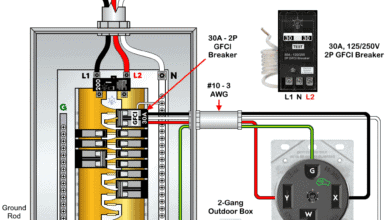Part 10 – Overcurrent Protection for Motor Control Circuits
How to Size Short Circuit and Overload Protective Devices for Motor Control Circuit Conductors?
According to 430.75(A), motor control circuit must have a disconnect. If the motor control circuit conductors are tapped from the motor controller disconnect, it will be able to serve as disconnecting means l for the control circuit conductors as located in sight from the motor controller location. – 430.102
a separate disconnect for the motor control circuit is required if the control circuit is not tapped from the controller disconnect and supplied by a Class 1 control circuit. In that case, the control circuit disconnect and controller disconnect must be adjacent to each other.
Overcurrent protection must be provided to the motor control circuit as specified in 430.72. If the control circuit conductors are tapped from the load side of motor protective device (OCPD), such circuit shall not be considered as a branch circuit and must be protected by a supplementary overcurrent protection device. Motor control circuits other than tapped control circuits are permitted to be protected against overcurrent in accordance 724.43.
The overcurrent protection to the control circuit conductors must be provided as per 430.72(B)(1) or (B)(2) as follow:
1. A separate overcurrent protection device is required if the motor branch circuit protection against short-circuit and ground fault by protective devices doesn’t provide protection as per 430.72(B)(2). In this case, the rating of overcurrent device shall not exceed the values of maximum rating of overcurrent protective device in amperes specified in Column A of Table 430.72(B)(2).
2. All other and control circuit conductors must be protected against short circuit and ground faults. The rating of the protective device shall not exceed the value specified in column B of 430.72(B)(2) for conductors within enclosure If the conductors do not extend beyond the motor control equipment enclosure.
3. The rating of the protective device(s) shall not exceed the value specified in column C of Table 430.72(B)(2) if the conductors extend beyond the motor control equipment box.
Sizing Protection against Overload, Short Circuits & Ground Faults for Motor Control Circuit Conductors
Motor control circuit conductors should be protected from overload, short circuits, and ground faults. While short-circuit and ground-fault protection are used to prevent damage and hazards, overload protection is also prevents overheating and potential fires, especially in motor circuits. In short, the control circuit conductors must be protected against short circuit and ground faults like the branch circuit conductors used for motor circuits.
Sizing and overcurrent protection for the control circuit conductors are similar to the previous sections of sizing motor branch circuit conductors and sizing motor overcurrent protection and OCPD’s devices for branch circuit conductors.
Example 1: Sizing Overcurrent Protection for Motor Control Circuit Conductors
What is the suitable size of overcurrent and overload protection devices are required for control circuit conductors for a 1-hp, 120V motor with a nameplate current rating of 13.5A?
Solution:
Since the the same conductors are used for both motor branch circuit conductors and motor control circuit conductor, the required conductor are sized as per 430.22 based on motor full load current (FLC) in table 430.248. Since the value of FLC is 16A for single phase 120V motor, and the conductor must be sized 125% of the FLC, thus;
16A × 125% = 20A
Based on this calculation, the Table 310.16 suggests 14 AWG at 60°C. For this wire size, the rating of short circuit and ground fault circuit protective device is calculated in accordance 430.52(C)(1) based on the full load current:
16A × 250% = 40A
Hence, the next level up standard OCPD rating is 40A.
The rating of overload protective device is determined as per 430.32(A)(1) based on the nameplate current rating.
13.5A × 115% = 15.5A
For overcurrent protection, the 40A protective device protects the motor from short circuit and ground faults while the 15A protective device protects the motor and associated 14 AWG branch circuit and control circuit conductors from overcurrent.
Example 2: Sizing Separate Overcurrent Protection for Motor Control Circuit Conductors
What is the required size of separate overcurrent protection device for control circuit conductors operated at 120V and used with a 1 HP, 230V, 9A single phase motor? The rating of the transformer output or relay/contactor as a control device is 300VA, 120V.
Solution:
Separate Control Circuit Conductors
As the transformer output or the rating of the control circuit used with main relay/contactor is 120V, 300 VA. Hence,
I = P ÷ V
I = 300 ÷ 120V = 2.5A
Now, if we have to use a separate control circuit disconnect (such as 1P, 120V breaker) for the control device other than the 2P main control disconnect, for the 2.5A control circuit conductors, the minimum required size for the wiring circuit by NEC is 14 AWG – 310.5. Due to the motor load circuits, some local code suggests to use #12AWG instead of #14AWG.
Keep in mind this protective device only protects the control circuit conductors (Not the main control unit and associated conductors) from the short circuit and ground faults, but not from overload conditions.
Motor Controller & Branch Circuit
As mentioned in the 1st example, conductors are sized as per motor full load current (FLC) based on table 430.248 in accordance with 430.22 which is 8A for 1HP, 230V motor. The size of conductor must be sized 125% of the full load current.
8A × 1.25 = 10A
For 10A, the minimum required size of conductor is #14AWG using NEC Table 310.16. Now, the short circuit and ground fault protection for the motor branch circuit conductors (not the control circuit conductors) are sized in accordance 430.52(C)(1) based on FLA.
For this wire size, the rating of short circuit and ground fault circuit protective device is calculated in accordance 430.52(C)(1) at 250% based on the full load current:
8A × 250% = 20A
Overload Protection
The overload protection is calculated based on motor’s nameplate current rating in accordance with 430.32(A)(1)
9A × 1.15 = 10.35A
This way, the rating of overload protective device must not exceed the 10.35A. Hence, the appropriate value of OL relay for overload protection is 10A.
Based on the calculations, the overcurrent protection and conductor sizes for a 1 HP, 230V, single-phase motor are as follows:
- Motor branch circuit and control circuit conductor size: #14 AWG
- Short-circuit and ground-fault protective device rating for motor branch circuit conductors: 20A
- Separate short-circuit and ground-fault protective device rating for motor control circuit conductors: 10A
- Overload protective device rating for both motor branch and control circuit conductors: 10A
Series Overview: Motor Circuit Calculations
- Part 1 – Motor Load Circuits: NEC Terms and Basic Terminologies
- Part 2 – NEC Requirements for Motor Circuits
- Part 3 – Understanding NEMA Motor Nameplate Data
- Part 4 – Calculating Locked Rotor Current (LRC) for Motors
- Part 5 – Sizing Motor Branch Circuit Conductors
- Part 6 – Sizing Motor Feeder Conductors
- Part 7 – Sizing Motor Overcurrent Protection and OCPD’s Devices
- Part 8 – Sizing Motor Feeder Protection
- Part 9 – Sizing Motor Overload Protection
- Part 10 – Overcurrent Protection for Motor Control Circuits
- Part 11 – Sizing Disconnecting Means for Motor & Controller
- Part 12 – Sizing Motor Starter & Contactor – NEMA – NEC
- Part 13 – Sizing Direct Online (DOL) Starters/Contactors for Motors (*Bonus)
- Part 14 – Sizing Star-Delta Motor Starters/Contactors for Motors (*Bonus)
Resources & Tutorials:
- Cable Size Calculation for LT & HT Motors
- Three Phase Motor Power & Control Wiring Diagrams
- What is Motor Efficiency & How to improve it?
- Star Delta 3-phase Motor Automatic starter with Timer
- How to Run a Three-Phase Induction Motor on a Single-Phase Power Supply?
- How to Wire ST01 Timer with Relay & Contactor for 120V/240V Motors?
- How to Wire Twin Timer in Repeat Cycle & One-Shot Mode for 120V/240V Motors?
- How to Control a Single-Phase Motor from Multiple Locations?
- Automatic & Manual Control of Motor Using VFD & DOL Starter
- How to Reverse and Forward a Three-Phase Motor Using a VFD?
- How to Wire a VFD with Motor, PLC, Switches & External Devices
- Sequential Motor Control Circuit Using LOGO! V8 PLC
- Automatic Reverse Forward Motor Control Circuit Using Delta – DVP-14SS PLC
- Reverse Forward Motor Control Circuit Using PLC – ZEN Programming Relay
- Motor Protection – Types of Faults and Protection Devices
- Cables Feeder Protection – Faults Types, Causes & Differential Protection
Wire Sizing Guides
- How to Find the Proper Size of Wire & Cable In Metric & Imperial Systems
- How to Size a Branch Circuit Conductors with Protection?
- How to Size Feeder Conductors with Overcurrent Protection
- How to Size Service-Entrance Conductors and Feeder Cables?
- How to Size Equipment Grounding Conductor (EGC)?
- How to Size Grounding Electrode Conductor (GEC)?
- What is the Right Wire Size for 15A Breaker and Outlet?
- What is the Suitable Wire Size for 20A Breaker and Outlet?
- How Size a Circuit Breaker for Different Load Applications







